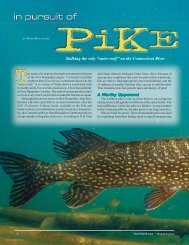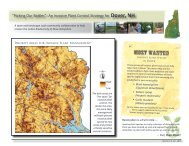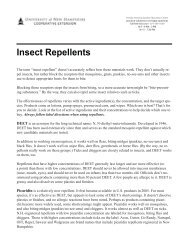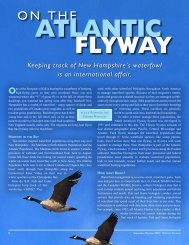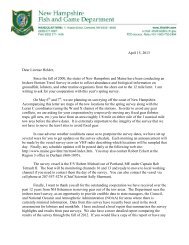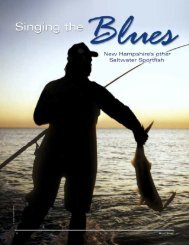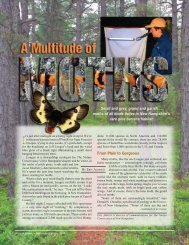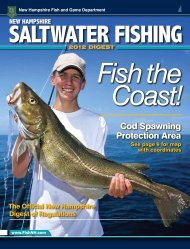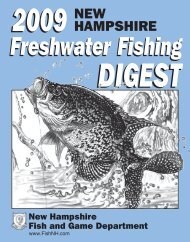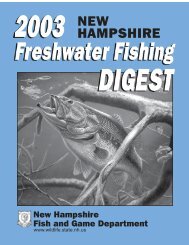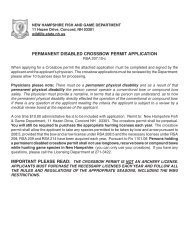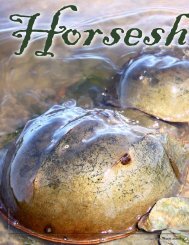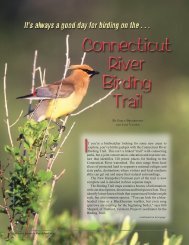Mad for Molluscs - New Hampshire Fish and Game Department
Mad for Molluscs - New Hampshire Fish and Game Department
Mad for Molluscs - New Hampshire Fish and Game Department
You also want an ePaper? Increase the reach of your titles
YUMPU automatically turns print PDFs into web optimized ePapers that Google loves.
areas are still subject to temporary closures, which<br />
can last days, weeks, or even months, depending<br />
on the kinds of pollution sources in the area.<br />
In some years, an ocean outbreak of Paralytic<br />
Shellfish Poisoning, or PSP, – commonly known<br />
as “red tide” – can make <strong>New</strong> <strong>Hampshire</strong>’s shellfish<br />
off-limits to harvesters <strong>for</strong> long periods. PSP<br />
is caused by a “bloom” of toxic organisms, <strong>and</strong><br />
can be dangerous or even deadly to humans who<br />
eat contaminated shellfish.<br />
In addition to pollution or PSP-related<br />
shellfishing closures, N.H. <strong>Fish</strong> <strong>and</strong> <strong>Game</strong> implements<br />
restrictions <strong>for</strong> resource conservation<br />
purposes, which vary by species. The best way <strong>for</strong><br />
harvesters to keep track of what areas are open is<br />
to consult the maps in the N.H. <strong>Fish</strong> <strong>and</strong> <strong>Game</strong>’s<br />
Saltwater Digest, or on the <strong>Department</strong> of Environmental<br />
Services website at<br />
www.des.state.nh.us. If an area is shown as being<br />
open, harvesters should then consult the “Clam<br />
Flat Hotline” (1-800-43-CLAMS) to see if a temporary<br />
closure is in place <strong>for</strong> their area of interest.<br />
Tools of the Trade<br />
Shellfish harvesting does not require a large<br />
investment in equipment, though clam or oyster<br />
harvesters — N.H. residents only — must get a<br />
$30 permit from any license agent. Shellfish areas<br />
tend to be wet, muddy <strong>and</strong> sometimes slippery<br />
places, so rubber boots are a good idea. Hip or<br />
chest waders are ideal <strong>for</strong> keeping mud off your<br />
clothes (<strong>and</strong> the inside of your car!), crossing tidal<br />
creeks, <strong>and</strong> wading into knee-deep water to rinse<br />
your shellfish <strong>and</strong> equipment. Gloves to protect<br />
h<strong>and</strong>s from sharp shells <strong>and</strong> abrasive s<strong>and</strong> <strong>and</strong><br />
mud are also a good idea.<br />
Harvesting mussels requires no equipment, as<br />
it is typically done by h<strong>and</strong>. But a clam <strong>for</strong>k is<br />
needed to dig <strong>for</strong> softshell or razor clams. H<strong>and</strong>les<br />
must be less than 18" long, <strong>and</strong> can be purchased<br />
from local marine equipment <strong>and</strong> fishing tackle<br />
stores.<br />
You need some sort of basket to hold your<br />
catch. Some people buy a specialized metal clam<br />
basket, which allows water <strong>and</strong> mud to flow<br />
through <strong>and</strong> helps with the task of rinsing mud off<br />
the shellfish. If you plan to use a plain 5-gallon<br />
bucket, make a line with permanent marker at the<br />
10-quart mark, to ensure you don’t exceed the<br />
daily limit. Keep in mind that your license number<br />
must be clearly marked on the outside of the clam<br />
container <strong>and</strong> your license must be worn in plain<br />
view while harvesting.<br />
Oyster tongs are long-h<strong>and</strong>led, hinged implements<br />
that can be a little more challenging to find,<br />
but are necessary <strong>for</strong> accessing oysters in deeper<br />
water. Check the Internet <strong>for</strong> companies that manufacture<br />
them.<br />
continued on next page<br />
Proper clam digging is one way to help protect <strong>and</strong> improve <strong>New</strong> <strong>Hampshire</strong><br />
clam stocks. Here’s the best technique:<br />
1. Select <strong>and</strong> cut a manageable<br />
section of flat on four sides.<br />
3.Turn the piece of flat completely<br />
over <strong>and</strong> place it in the resulting<br />
furrow. (Placing the piece to one<br />
side may needlessly cover an undug<br />
area with small clams vulnerable to<br />
smothering.)<br />
5.With <strong>for</strong>k tines straight downward,<br />
gently break up the section of flat to<br />
expose the remaining clams.<br />
2.Try to judge the location <strong>and</strong> depth<br />
of most clams of suitable size. Work<br />
<strong>for</strong>k into the flat with gentle rocking<br />
motion, adjusting angle of <strong>for</strong>k to<br />
move between <strong>and</strong> under the clam<br />
burrows.<br />
4.Pick out the exposed clams that<br />
are of suitable size.<br />
NECK<br />
FOOT<br />
6.When all harvestable clams have<br />
been taken from the piece, simply<br />
leave it as it lies in the furrow. This<br />
protects the remaining clams from<br />
predators such as crabs <strong>and</strong> gulls.<br />
Clams not harvested will gradually<br />
return to an upright feeding position.<br />
NH DES SHELLFISH PROGRAM PHOTO<br />
A clam <strong>for</strong>k is the<br />
best tool <strong>for</strong> turning<br />
over sections of mud<br />
flat to find softshell<br />
clams.<br />
WILDLIFE JOURNAL • July/August 2006 11



